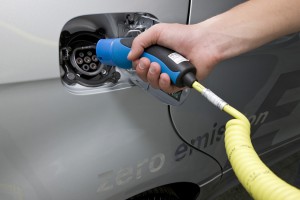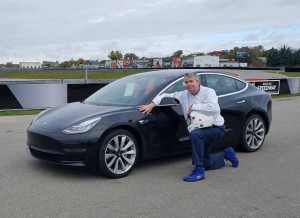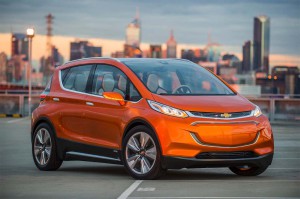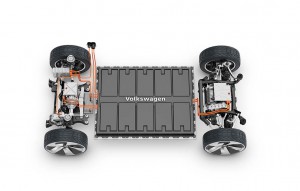
A new study shows that cold impact electric vehicles in ways and severity not previously realized by the auto industry.
When the Polar Vortex put most of the country under a deep freeze, the impact was particularly hard felt by those driving battery-electric vehicles.
How much an EV’s range drops depends upon a variety of factors, according to industry research, and backed up by a new study, but even when it’s just a bit below zero it’s not unusual for owners to see the range of a battery car like the Nissan Leaf or Chevrolet Bolt EV tumble by 40% or more, AAA researchers discovered.
“I’m consistently seeing a 30% degradation” in range on cold days, said Henry Payne, an automotive reviewer for the Detroit News and an owner of a Tesla Model 3. When the floor fell out under the weight of the Polar Vortex, he added, he lost a full 50% of the sedan’s normal range.
The bigger number was what I experienced during the depths of the recent cold spell while driving a Jaguar I-Pace. Compounding the problem, cold weather can also make it more slow and difficult to recharge a BEV’s battery pack.
(Hispano Suiza to reveal electric “hyperlux” car in Geneva. Click Here for the story.)
“We found that the impact of temperature on EVs is significantly more than we expected,” said Greg Brannon, AAA’s director of Automotive Engineering.

Detroit News auto reporter Henry Payne said he sees a 30% drop in range with his Tesla Model 3 on cold days. It dropped 50% during the polar vortex. (Photo credit: Henry Payne)
Though problems with battery range have become increasingly well-documented as more and more of the vehicles go into service – especially in regions outside of sunny California – the AAA set out to develop a more formal analysis of the problem.
It started out with five longer-range battery-electric vehicles or BEVs: the BMW i3, the Chevrolet Bolt EV, the Nissan Leaf, the Tesla Model S and the Volkswagen e-Golf. It used rigorous methodology to expose them to set temperatures – at the cold end, 20 degrees Fahrenheit – and test the impact on range in a repeatable fashion.
In the end, the results weren’t out of line with what EV owners have been reporting anecdotally.
Simply turning on the EVs AAA studied in 20 degree weather revealed a 12% loss in range. On a vehicle like the Chevy Bolt, with an EPA rating of 238 miles per charge, that would drop range to 209 miles. But that part of the test assumed operating the vehicle with neither cabin heat or even seat-heaters turned on.
Using climate control revealed an even bigger surprise, according to Brannon, as range dipped by an average 41% – which would bring an EV like the Bolt down to just 140 miles of range.
The impact of using a cabin heater was one of the bigger surprises that emerged from the research, according to AAA’s Brannon, being more significant than expected. And the results were largely the same no matter what type of climate control system a vehicle used, whether a conventional resistance-style heater or a heat pump.

The range of the Chevy Bolt would drop from 238 miles to 209 miles with just a 12% drop in range due to cold.
Motorists might be surprised to realize turning on the heater can impact range so much – largely because it doesn’t in a vehicle using a conventional gas or diesel engine. Their heaters simply tap some of the waste heat that would normally be discarded through the radiator.
The loss of range in winter conditions didn’t even factor in the impact of running a car’s headlights, something more common when the days are so short.
EV range also can be impacted by driving style, the terrain you’re driving in and other factors. On the positive side, driving less aggressively can help minimize the impact of cold weather.
There are other steps you can take. For one thing, use seat heaters, rather than cabin heat – or, at the least, lower the cabin heater, automakers advise.
(Click Here for more about VW subsidiary buying Tesla Powerpacks for its charging stations.)
The good news is that most battery-electric vehicles can be “pre-conditioned” when they are plugged into a charger, notes Timothy Grewe, chief engineer for General Motors’ electric propulsion systems. That means a motorist can use a smartphone app to start warming the vehicle’s cabin before they leave home, office or store, saving a few kilowatts of battery power, since the energy comes from the grid. Commuters can even set a regular time for their BEVs to start pre-conditioning so they’re always warm before heading to or from work.
Some vehicles also pre-condition the battery which means it can store – and deliver – more energy.
One of the reasons battery cars lose range in the winter is that, like humans, lithium-ion chemistry prefers to operate at temperatures of around 70 degrees Fahrenheit. At colder temperatures, the internal components become more resistant to passing current.
“The flow of energy is reduced and you lose more capacity,” Grewe explains.
Cold temperatures also impact charging. How much slower the battery charges “depends on several factors,” explained Jonathan Levy, the vice president of strategic initiatives for EVgo, one of the country’s largest operators of public charging stations.
That includes the basic chemistry used in each different vehicle’s battery pack. They all may be called “lithium-ion,” but there are more than a dozen different “families,” or compounds, that mix in different formulations of materials like cobalt, iron and manganese. Each responds to cold in a different way.
Then there’s the design of the battery pack containing hundreds, even thousands of individual battery cells. The Nissan Leaf uses a simple and relatively inexpensive air-cooling system. The I-Pace, Tesla Model 3 and many other BEVs rely on more expensive liquid-cooled systems. One disadvantage is that they more energy on their own, especially on very hot or cold days. The plus side is that liquid-cooled battery packs tend to remain closer to their optimum operating temperature.
If you’re not located in one of the country’s colder regions be aware that hot climates also can pose problems.
“Much like when it’s cold, in hot weather EVs suffer some decrease in range, but not as much as in the cold.”
(BCG study forecasts 50% of vehicles sold in 2030 will be “electrified.” For the story, Click Here.)
The AAA study found range fell 4% from EPA numbers at 95 degrees. But, again, that number was assuming the motorist didn’t mind sweating. Turn the climate control system down to 70 degrees, AAA found and range fell by 17%.


That was the first supportable data I’ve seen on climate effects on EV range. Excellently written article about a good study. I’m wondering if automotive reverse cycle heat pumps might help with the heating efficiency. Home units are the most common form of heating in the southeast and are 2 to 3 times more efficient than resistance heating in this environment. Here in northern Alabama daytime temps are seldom below freezing and solar heating provides most of the cabin heat once it is warmed up. I was more interested in the AC hit and was surprised that it was only 17 percent.
Thanks for the kind words. I was glad to see an effort to scientifically quantify the anecdotal reports on how cold weather impacts range — something I have personally experienced with two BEVs I have driven this winter, the Jaguar I-Pace and Kona EV. As to cabin heating, AAA’s Brannon stressed that they saw virtually no difference between different heating systems, resistance or heat pump, which came as a surprise. We’ll be watching to see if automakers can improve their efficiency going forward.
Paul E.
“Using climate control revealed an even bigger surprise, according to Brannon, as range dipped by an average 41%”, AAA’s director of Automotive Engineering.
If he’s surprised, I’d like to know which Alma Mater is proud to have him as an alumnus?
I don’t really consider +20F to be all that cold. How much does the battery loss increase (if it does) at -20F? “One disadvantage is that they more energy on their own…” I am guessing the sentence is supposed to read, “One disadvantage is that they use more energy on their own…”
Hoping AAA will follow up with more studies. I can tell you that when temps went sub-zero in Detroit I saw declines of as much as 50% of range on two EV models.
Paul E.
I can tell you that the normal range for my 2014 Volt is around 39 mi, but this time of year I average 26 mi or so.
Last week, when the temps dropped below 17F, the engine insists on running. When things dipped below 0F, the engine ran nearly all the time – just to keep things warm.
As a consequence, I always use more gas in my commute (about 10 mi a day), during the winter.